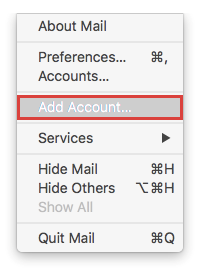Different Email Applications For Mac That Support Tls 1.2
If you are using Internet Explorer 10, update to Internet Explorer 11 or follow the steps below to enable TLS 1.2: Open Internet Explorer. Expand the Tools menu by selecting the gear icon in the top right of the browser. Then, select Internet Options. The Internet Options window will display. On the Internet Options window, click the Advanced tab. The server responds with, “I don’t speak TLS 1.2, but I do speak TLS 1.0, so let’s agree to use that.” They then use that downgraded protocol as their preferred encryption method. The downgrade sequence could ALSO downgrade the encryption to use SSL 3.0, if necessary. TLS Protocol Version 1.0 is not secure and as a result, needs to be disabled on servers that offer PCI compliance. All of our servers are PCI Compliant-ready and therefore we have disabled it across our entire hosting platform. Currently, we only support TLS 1.2. Goodbye TLS 1.0 and 1.1. In this example an application could only use TLS 1.2 if the application specifically called for TLS 1.2. If the application did not specifically call for TLS 1.2, then it would not be able to use TLS 1.2 as even though the protocol is enabled, it is not in the default list of available protocols. I have TLS 1.0, 1.1, and 1.2 enabled. (can't disable 1.0 because SQL won't start without it but that's another story). It didn't work at first but after I put the server in compatible mode by adding a key to the registry, it works.
[last update 2018-06-08] GnuTLS already contains support for the latest TLS 1.3 draft (draft-ietf-tls-tls13-26) on its master git branch. TLS 1.3 will be included and enabled by default in the upcoming 3.6.3 release, once the final version of TLS 1.3 protocol is published. One of our major challenges related to TLS 1.3 protocol, was making its support transparent for existing applications; that is, without any code changes or the need for re-compilation.
Midlleware for converting emails to pdf on a mac. You can also add pages or delete pages. From there you can add texts or delete texts.
Best mac software for volume repairs. We believe we have sufficiently addressed that challenge, while at the same time made available several new features introduced by the protocol. This post will go through the new features of TLS 1.3, and discuss how one can take advantage of them with GnuTLS. We will also discuss potential pain points during the migration.
Free Applications For Mac Os X
More information will be provided in the. New features under TLS 1.3 Unlike its predecessors which were consisting of incremental updates, TLS 1.3 is a clean-slate re-write of the TLS 1.2 protocol. In brief, on the algorithmic level the changes are quite minimal, with the support for RSA-PSS signatures being the most significant change, and the elimination of all ciphers which had known issues.

On the protocol level, the changes span many aspects, mainly changes to reduce the message roundtrips during handshake, and several security related fixes and protocol simplifications. These changes include the complete elimination of the convoluted re-handshake process, and replace it by the simpler re-key and re-authentication processes. They also include the defense against passive eavesdroppers for the certificates sent during handshake, the introduction of a foundation for message length hiding, and the ability to attach OCSP staples to all certificates sent during handshake. Testing TLS 1.3 In the master branch of GnuTLS, TLS 1.3 is not enabled by default. An application can enable it with a priority string like the following: 'NORMAL:-VERS-ALL:+VERS-TLS1.3:+VERS-TLS1.2'. That step will not be necessary once the draft is finalized. Single roundtrip handshake In contrast with TLS 1.2 which had a handshake message round-trip of 2, the TLS 1.3 handshake process typically takes a single round-trip.
Game Applications For Mac
The idea behind that optimization is that the client sends its key shares for the key exchange speculatively, by guessing the Diffie-Hellman group(s) the server supports. If that speculation fails, the handshake falls backs to a more verbose mode which includes two additional messages (Hello-Retry-Request and ClientHello) to negotiate the commonly supported groups. In GnuTLS the client sends by default the key share of the two distinct group types which have the highest priority; currently that is the elliptic curve groups SECP256R1 and X25519. The reason key shares from these two groups were selected is because they are widely available, and require little resources from a CPU-time perspective, while minimizing the risk of fall-back to the more verbose handshake. In order to modify that behavior, applications can re-order the preferred group list via priority strings, and/or provide a special flag to gnutls_init() which switches the behavior. The flag GNUTLS_KEY_SHARE_TOP instructs GnuTLS to send a single key share, GNUTLS_KEY_SHARE_TOP3 to send the top 3 distinct group key shares (e.g., SECP256R1, X25519 and FFDHE2048). Note however, that the round-trips achieved by TLS 1.3 do not translate to network roundtrip when operating under TCP.